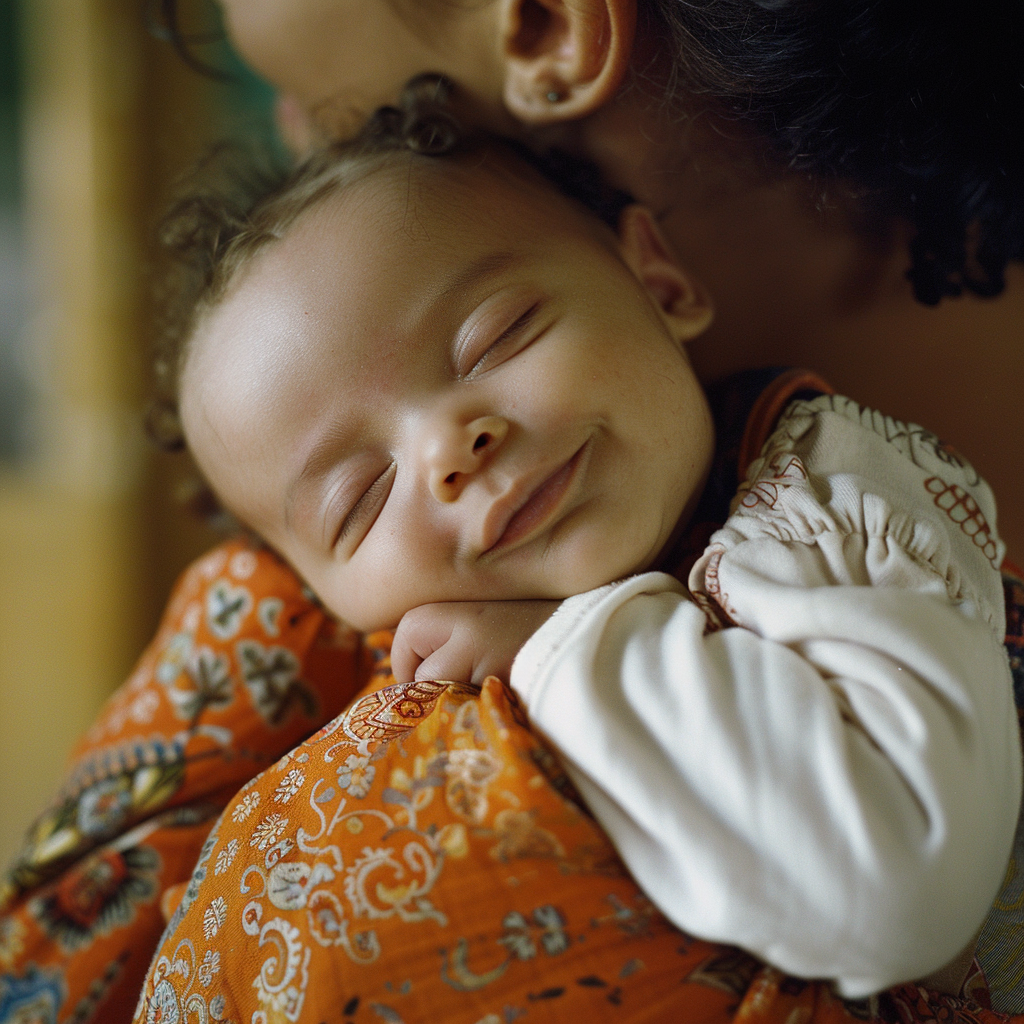
Welcome, new parents! Navigating the first few months with a new baby can be both exhilarating and exhausting. One of the most common challenges you might face is understanding and adapting to your baby’s sleep needs. Sleep is crucial not only for your baby’s health and development but also for your well-being.
In this comprehensive guide, we’ll explore everything you need to know about sleep patterns, schedules, and environments for your newborn in the first three months of life. From decoding sleepy cues to setting up the perfect sleep setting, and creating a sleep-friendly routine, we’ve covered it all. Plus, you’ll find a weekly sleep chart that offers a clear view of what typical sleep looks like during these early weeks.
Whether you’re trying to make sense of naps or nighttime rituals, this guide is designed to help you provide the best sleep environment for your little one, ensuring restful nights for the whole family. Let’s help you and your baby get the rest you both deserve!
Understanding Sleep Patterns
Newborn Sleep Patterns
- Irregular and Frequent: In the early weeks, newborns don’t have a set sleep schedule. They sleep in short bursts, which can be as short as 20 minutes or as long as 4 hours, both day and night. This is because their tiny stomachs need frequent feedings.
- Total Sleep Time: Newborns typically need a lot of sleep, ranging from 14 to 17 hours a day. This high sleep requirement supports their rapid growth and brain development.
- Developmental Changes: As babies grow, their sleep cycles start to lengthen, and they gradually develop a more regular sleep pattern. Around 6-8 weeks, you might start to notice longer stretches of sleep, especially at night.

Sleeping Cues
- Early Signs of Sleepiness: Look for subtle cues that your baby is getting tired, such as yawning, rubbing eyes, or becoming less engaged with their surroundings. These are signs it’s time to start winding down for a nap or bedtime.
- Late Signs of Sleepiness: If your baby becomes fussy, starts crying, or shows signs of being overstimulated, they might be overtired. Try to catch their early sleep cues to prevent overtiredness, which can make it harder for them to fall asleep.
Room Environment
- Temperature: Babies sleep best in a room that is comfortably cool. Aim for a room temperature between 68-72°F (20-22°C). Dress your baby in light, breathable clothing appropriate for the season.
- Lighting: Keep the room dim during naps and nighttime sleep to help signal to your baby that it’s time to rest. Use blackout curtains to keep the room dark, especially during daytime naps.
- Noise: Using a white noise machine or a fan can help create a consistent background noise that masks sudden sounds, which might startle your baby awake. This can create a more soothing and stable sleep environment.
- Crib Safety: Always place your baby on their back to sleep on a firm mattress with a fitted sheet. The crib should be free of loose bedding, pillows, toys, and bumpers to reduce the risk of Sudden Infant Death Syndrome (SIDS).
Sleep Schedule
0-1 Month
- Daytime: Expect your baby to take multiple short naps throughout the day. These naps can vary in length but usually last between 30 minutes and 2 hours.
- Nighttime: Nighttime sleep is also fragmented, with your baby waking every 2-4 hours for feedings. This frequent waking is normal and necessary to ensure they are well-fed.
- Total Sleep: On average, newborns sleep about 16-17 hours per day. This includes both daytime naps and nighttime sleep.
1-2 Months
- Daytime: Your baby will still take frequent naps, but you may start to see a bit more predictability in their sleep patterns. Some naps may begin to lengthen.
- Nighttime: You might start to notice slightly longer sleep stretches at night, though waking every 3-4 hours for feedings is still common.
- Total Sleep: Babies at this age typically sleep around 15-16 hours per day.
2-3 Months
- Daytime: By now, your baby might be taking 3-4 more structured naps during the day. These naps can range from 30 minutes to 2 hours.
- Nighttime: Some babies may start to sleep longer stretches at night, potentially up to 5-6 hours. However, waking for feedings is still common.
- Total Sleep: The total sleep time for a 2-3 month old is generally around 14-16 hours per day.

Weekly Sleep Chart
| Week | Total Sleep (hours/day) | Daytime Sleep (hours) | Nighttime Sleep (hours) |
| 1 | 16-17 | 8-9 | 8-9 |
| 2 | 16-17 | 8-9 | 8-9 |
| 3 | 16-17 | 8-9 | 8-9 |
| 4 | 16-17 | 8-9 | 8-9 |
| 5 | 15-16 | 7-8 | 8-9 |
| 6 | 15-16 | 7-8 | 8-9 |
| 7 | 15-16 | 7-8 | 8-9 |
| 8 | 15-16 | 7-8 | 8-9 |
| 9 | 14-16 | 6-8 | 8-9 |
| 10 | 14-16 | 6-8 | 8-9 |
| 11 | 14-16 | 6-8 | 8-9 |
| 12 | 14-16 | 6-8 | 8-9 |
What to Use and Do
For Better Sleep
- Swaddling: Swaddling can help your newborn feel secure and prevent their startle reflex from waking them up. Make sure to swaddle snugly but not too tightly, and stop swaddling once your baby shows signs of rolling over.
- Pacifiers: Offering a pacifier at sleep times can help soothe your baby and has been shown to reduce the risk of SIDS. If your baby doesn’t take to a pacifier, don’t force it, but it can be a helpful tool for many infants.
- Consistent Bedtime Routine: Establish a simple bedtime routine to signal to your baby that it’s time to sleep. This can include a warm bath, gentle rocking, reading a book, or singing a lullaby. Consistency is key to helping your baby recognize when it’s time to wind down.
- Feeding: Ensure your baby is well-fed before sleep to help them rest longer. However, try not to let them fall asleep while feeding as they get older, as this can create a sleep association where they need to be fed to fall asleep.
Additional Tips
Safe Sleep Practices
- Back to Sleep: Always place your baby on their back to sleep. This position significantly reduces the risk of SIDS.
- No Co-Sleeping: Avoid sharing a bed with your baby. Instead, keep their crib or bassinet close to your bed for convenience and safety.
- Smoke-Free Environment: Ensure your baby’s sleeping area is smoke-free. Exposure to smoke increases the risk of SIDS.
Managing Day and Night Confusion
- Daytime: Keep the environment bright and engage your baby with play and interaction during awake periods to help them learn the difference between day and night.
- Nighttime: Keep lights dim and noise levels low during nighttime feedings and diaper changes to reinforce that nighttime is for sleeping.
Handling Sleep Regressions
- Expect Changes: Growth spurts, developmental milestones, and changes in routine can temporarily disrupt your baby’s sleep patterns. Be patient and stick to your routine as much as possible.
- Stay Consistent: Maintain your sleep routine and environment consistently. Your baby will eventually adjust back to their regular sleep pattern.
Congratulations on your new arrival! These first few months can be challenging as you and your baby adjust to new sleep patterns, but establishing healthy sleep habits early on will set the foundation for better sleep as your baby grows. Remember, each baby is unique, and it’s important to be flexible and responsive to your baby’s needs. Trust your instincts, and don’t hesitate to seek support from your pediatrician or a sleep consultant if needed.



